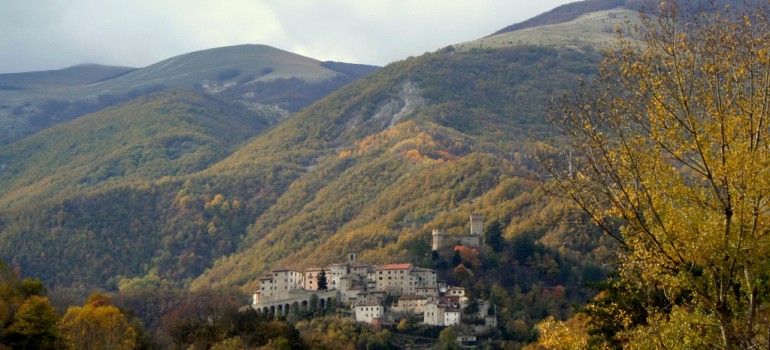
Arquata del Tronto is located 777 m. above sea level in the south-western area of the Marche Region, and it borders on Abruzzo, Lazio and Umbria. Its territory, largely mountainous, ranging from 580 to 2478 meters above sea level, is crossed east- west by the river Tronto which separates the Sibillini range from Monti della Laga. There is no evidence of the origin of Arquata. Historians identify it with the ancient Surpicanum, situated between the two ” Statio ” of the Tavola Peutingeriana , Ad Martis and Ad Aquas. The first mentions of Arquata date back to the 11th century when it offered itself to Ascoli gaining full autonomy. During the 14th century Arquata enjoyed a relative independence from Ascoli ( 1337 ) until 1429 when it was given to Norcia by Pope M.V^ belonged to Norcia until 18th century. After the French invasion of 1809, the prefecture of Norcia was abolished and Arquata was taken over by Spoleto. In that period the fortress was restored and equipped with bunkers and artillery; it was given a permanent garrison and it was declared, together with Spoleto and Perugia, the third fortress of the department. After the Napoleonic era, during the Papal government, Arquata joined once again Ascoli (1832). Arquata has 12 hamlets and its territory extends over two National Parks: Sibillini National Park to the north and the Gran Sasso – Monti della Laga Park to the south. The most interesting buildings are the medieval fortress (12th century) that dominates the town with its two towers (14th – 15th century) and the Church of the Annunciation where there is a wooden crucifix (13th century). In the village of Trisungo interesting are the remains of the ancient Roman road “Via Salaria” and a milestone 16-15 B.C. In the Church of St. Agata in Spelonga one can see a Turkish flag from the battle of Lepanto (1571), as well as numerous frescoes of the 15th and 16th century. In Capodacqua one can admire the octagonal Church of Our Lady of the Sun. In the hamlet Colle the Church of San Silvestro, built on top of the rock, has beautiful frescoes dated 1511. In the little village called Borgo the Church of San Salvatore preserves an ancient wooden crucifix of the Romanesque period and in the Church of St. Francis one can see an extract from the original Shroud and “La Madonna con il bambino e santi” a fresco probably painted by Cola dell’Amatrice .
Immagine in diretta aggiornata ogni 30 secondi.
La presente webcam non effettua alcuna registrazione video. Non ha funzioni di videosorveglianza e non conserva alcun dato personale. Ogni nuova fotografia sovrascrive quella precedente con refresh automatico, molto similmente ad una macchina fotografica che scatta le foto senza immagazzinarle in memoria. E’ possibile salvare le fotografie cliccando con il tasto destro del mouse sull’immagine e poi alla voce “Salva immagine con nome”. L’immagine è regolata per non recare disturbo alla privacy del vicinato dei passanti e ha l’unico scopo di diffondere in tempo reale le immagini provenienti territorio.